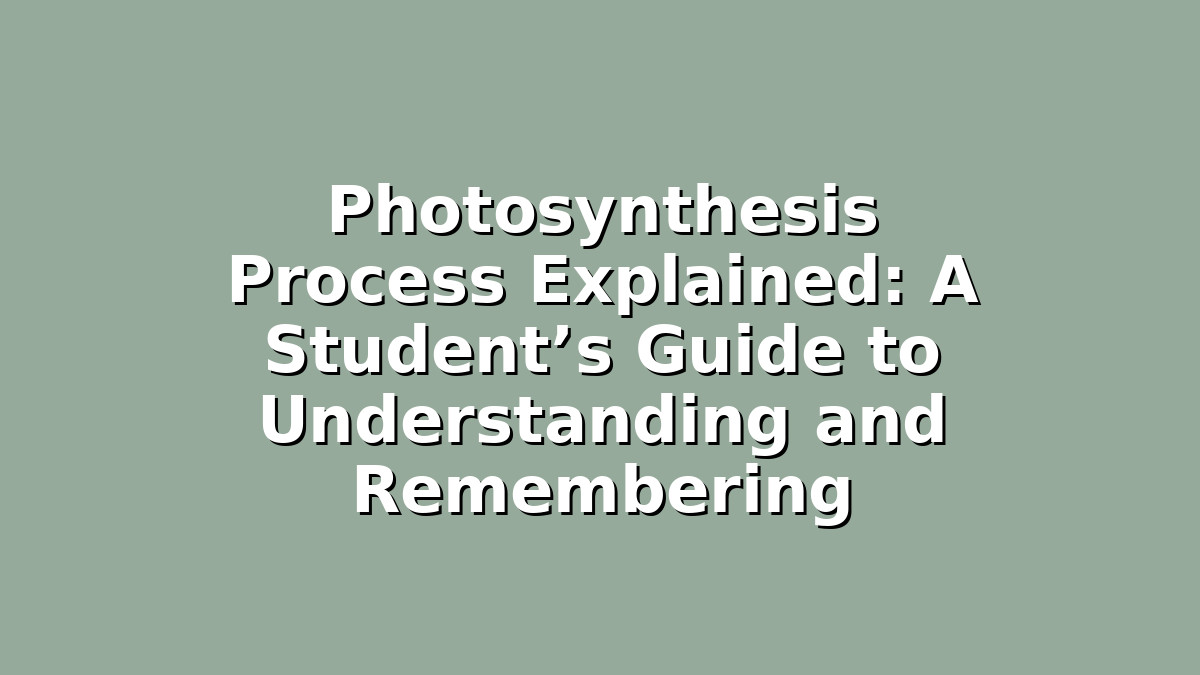If you’re a student preparing for exams or just looking to boost your understanding of biology, mastering the photosynthesis process is essential. Photosynthesis is a fundamental concept in biology that explains how plants make their own food and sustain life on Earth. Understanding this process not only helps you ace your exams but also gives you insight into the natural world around you.
In this article, we’ll break down the photosynthesis process in clear, easy-to-understand steps. We’ll also share some effective study tips to help you remember key details, so you feel confident when it’s time to answer exam questions. Let’s dive in!
What is Photosynthesis? A Simple Overview
Photosynthesis is the process by which green plants, algae, and some bacteria convert light energy into chemical energy. This process takes place mainly in the leaves of plants, specifically in specialized cell structures called chloroplasts. Chlorophyll, the green pigment in chloroplasts, absorbs sunlight and powers the chemical reactions.
In simple terms, photosynthesis allows plants to make glucose (a type of sugar) from carbon dioxide (CO₂) and water (H₂O). Oxygen (O₂) is released as a byproduct. The overall chemical equation for photosynthesis is:
6CO₂ + 6H₂O + light energy → C₆H₁₂O₆ + 6O₂
This means six molecules of carbon dioxide and six molecules of water, using light energy, are transformed into one molecule of glucose and six molecules of oxygen.
Study Tip #1: Use Mnemonics to Remember the Equation
To memorize this equation, try using a mnemonic or a phrase that helps you recall the reactants and products. For example:
“Clever Wizards Love Green Oak”
stands for CO₂ + Water + Light → Glucose + Oxygen.
Writing this down and repeating it aloud can reinforce your memory.
—
The Two Main Stages of Photosynthesis: Light-Dependent and Light-Independent Reactions
Understanding photosynthesis involves two major stages — the light-dependent reactions and the light-independent reactions (also called the Calvin cycle). Each stage plays a crucial role in converting sunlight into usable energy for the plant.
#### 1. Light-Dependent Reactions
These reactions occur in the thylakoid membranes of the chloroplasts. When chlorophyll absorbs sunlight, it becomes energized and uses that energy to split water molecules into oxygen, protons, and electrons. Oxygen is released into the air — which is why plants are so important for clean air! The electrons and protons help generate two energy-rich molecules called ATP (adenosine triphosphate) and NADPH, which power the next stage.
#### 2. Light-Independent Reactions (Calvin Cycle)
This stage occurs in the stroma, the fluid-filled area inside chloroplasts. The ATP and NADPH produced in the light-dependent reactions provide energy to convert carbon dioxide into glucose. This process involves several steps, including carbon fixation, reduction, and regeneration of the starting molecule, ribulose bisphosphate (RuBP).
Study Tip #2: Create Diagrams and Flowcharts
Visual aids can be incredibly helpful to understand and remember these steps. Try drawing a flowchart showing the two stages, including key inputs and outputs like water, oxygen, ATP, NADPH, and glucose. Labeling each part helps you visualize the process, and rewriting the information in your own words reinforces learning.
—
Why Photosynthesis Matters and How to Study It Effectively
Photosynthesis is more than just a biology topic — it’s the foundation of life on Earth. It fuels the food chain and maintains atmospheric oxygen levels. When you grasp its importance, you’re more likely to feel motivated to study it deeply.
#### Tips for Effective Study and Exam Preparation:
– Use Flashcards: Make flashcards for important terms such as chlorophyll, thylakoid, ATP, NADPH, and Calvin cycle. Testing yourself with these cards can boost recall.
– Teach Someone Else: Explaining the photosynthesis process to a friend or family member is a great way to test your understanding. If you can teach it clearly, you’ve mastered it!
– Practice Past Exam Questions: Look for exam questions related to photosynthesis in your textbook or online. Practice writing clear, concise answers that include key terms and processes.
– Break It Down: If the entire process feels overwhelming, study one stage at a time. Master the light-dependent reactions first, then move on to the Calvin cycle.
Study Tip #3: Set a Study Schedule and Take Breaks
Don’t cram all your studying into one session. Instead, spread your review over several days. After each study session, take a short break to let your brain absorb the information. Using techniques like the Pomodoro method (25 minutes study, 5 minutes break) can keep you focused and reduce burnout.
—
Conclusion
Photosynthesis might seem complex at first, but breaking it down into simple steps and using smart study techniques can make it easier to understand and remember. Remember the overall equation, understand the two main stages, and connect how each part fits into the big picture of sustaining life.
By using mnemonics, diagrams, flashcards, and teaching others, you can boost your confidence and improve your exam performance. Most importantly, stay positive and curious — mastering photosynthesis is a great step toward excelling in biology and appreciating the amazing world of plants.
Good luck with your studies!

Responses